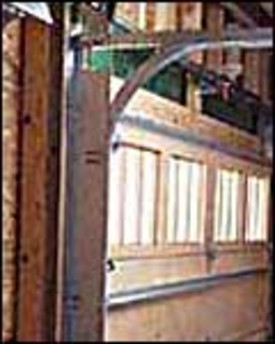 |
|
|
Custom garage doors can be made in nearly any configuration. Here, wood and glass combine to make inviting entryways.
|
|
Unless you’re planning to build new or replace an existing door, it’s unlikely you think much about your garage door. Still, it’s the largest moving part in your home and the broadest piece of curb appeal on display. Couple that with the safety considerations posed by moving doors, and a garage door discussion may be in your future. Before you head to the showrooms, catalogs, or online stores, take a look at your budget, preferences, home style, and family needs.
Door Types
Garage doors present a face and move up and down, so you’ll need to consider the style, material, and function of your door before purchasing. Most of the garage doors on the market are rolling sectional doors that travel up tracks on rollers, bending at each hinged section, as they are pulled overhead. A single section door pivots out in a single motion before being drawn by counterweights into place above the garage space. Single section doors may be impractical in areas with snow and ice, since the space in front of the door must remain clear for the door to function. People with single section pivoting doors should also watch that car bumpers, bicycles, visitors, and tools are not left too close to the garage door.
Finding a Fit
An average single garage door will be 9-feet wide by 7-feet tall. A two-car garage door will be 16-feet by 7-feet, or up to 20-feet wide and 8-feet tall. Once you’ve determined the size of your door, think about the space behind the door. If you have a garage workshop or tend to do projects in that space, you will want to consider insulating your garage door. Insulation protects against heat and cool temperatures, and insulates against sound as well. If you use your garage for storage, thermal insulation may be important. Homeowners with adjacent living space next to or above the garage will appreciate both the thermal protection and soundproofing that added insulation will provide.
Styles
Doors are typically available in recessed panel, raised panel, ranch, or flush designs. Customers can even order grooved or smooth panels, standard glass inserts, decorative inserts, or architectural designs. Each addition will raise the price of your door as you customize the look and function. A garage door can be a stylistic hallmark, though, so it’s worth matching the style of your door to the style of your home. Wood doors can be customized to a very high level, allowing the homeowner to match woods, style, details, and finishes. Paint and stain are options for wood and steel doors, should the available colors not suit your taste or décor.
 |
|
|
|
Sectional doors travel up tracks on rollers, bending at each hinged section. |
Insulation
There are various types of insulation available for garage doors. With metal doors, there are polystyrene and injected foam insulations available. Homeowners can choose a single metal face insulated with foam or polystyrene then finished with a second metal face or fiberglass inner face. There is an advantage to the injected foam since it bonds with the metal and eliminates voids. Polystyrene blocks are cut and fitted into the metal faces, often providing a lower R-value or insulation rating for the door. Providing a second face for the door to sandwich the insulation is the best way to maximize the insulative value of the foam or block. Wood doors may also be insulated, again by creating a sandwich between a wood face and interior facing. Wood, however, is an excellent insulator on its own.
Maintenance and Life Expectancy
While metal doors are far more resistant to damage from the elements than wood doors, any door will deteriorate if not cared for. Beware of dings, dents, and scratches when caring for your steel door. Inspect the door annually for any damage that might compromise the finish and lead to rust. Wood doors must be properly sealed and resealed every two years or so. Protect all garage doors from water, especially runoff and splashback from roof eaves. Direct water away from the door via gutters and eaves, allow a drainage area in front of the door that deters splashing or bouncing water from hitting the lower section of the door, and keep kid traffic from using the door as a backstop.
Credit: Renovate Your World




























